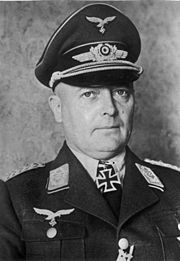| Richard Heidrich | |
|---|---|
 Richard Heidrich | |
| Born | 27 July 1896 |
| Died | 22 December 1947 (aged 51) |
| Place of birth | Lawalde, Kingdom of Saxony |
| Place of death | Hamburg-Bergedorf, Germany |
| Allegiance |
|
| Service/branch |
|
| Rank | General der Fallschirmtruppe |
| Commands held |
7. Flieger-Division 1st Fallschirmjäger-Division |
| Battles/wars | |
| Awards | Knight's Cross with Oak Leaves and Swords |
Richard Heidrich (27 July 1896 – 22 December 1947), was a highly decorated German Fallschirmjäger and general during World War II. He was also a recipient of the Knight's Cross of the Iron Cross with Oak Leaves and Swords (German language: Ritterkreuz des Eisernen Kreuzes mit Eichenlaub und Schwertern). The Knight's Cross of the Iron Cross and its higher grade Oak Leaves and Swords was awarded to recognise extreme battlefield bravery or successful military leadership.
Military career[]
Richard Heidrich volunteered for military service in World War I. He became an officer and won the Iron Cross 1st Class (Eisernes Kreuz 1. Klasse). After the war he was accepted by the Reichswehr, where he served in a number of posts in the infantry.
In 1938 Heidrich commanded the parachute battalion which he had formed as a Major in the infantry. Heidrich and his unit were transferred into the Luftwaffe on 1 January 1939. The Fallschirmjäger, while still in an early stage of formation, were thus augmented by a 2nd Battalion for the 1st Parachute Regiment. Heidrich was transferred to the staff of the 7th Air Division, but then left the Luftwaffe to lead the 514th Infantry Regiment in the Battle of France.
In June 1940 General Kurt Student was able to persuade Heidrich to transfer back to the Luftwaffe. He then formed the 3rd Parachute Regiment which he led with great success in the Battle of Crete.
In November 1942 Heidrich commanded the 1st Parachute Division, which was deployed on the Eastern Front. Starting 12 July 1943, the 1st Parachute Division was deployed to Sicily to counter the Allied invasion of the island. The division was directly involved in fighting around the Primosole Bridge.
The 1st Parachute Divisions toughest fighting came after the Allied landings on the Italian mainland, particularly in the three battles of Monte Cassino. Elements of the division under Heidrich's command also participated in the fighting at Anzio-Nettuno. As commanding general of the I Parachute Corps, Heidrich oversaw the corps’ withdrawal up the entire length of Italy.
Richard Heidrich was captured by the Americans on 2 May 1945 and was later handed over to the British. He died in a hospital in Hamburg-Bergedorf on 22 December 1947.
Awards[]
- Wound Badge (1914) in Black
- Iron Cross (1914), 2nd and 1st class
- Knight 2nd class of the Civil Order of Saxony, with Swords
- Knight's Cross Second Class of the Albert Order with Swords
- Cross of Honor
- Sudetenland Medal with Prague Castle Bar
- Fallschirmschützenabzeichen
- Clasp to the Iron Cross (1939)
- German Cross in Gold on 31 March 1942 as Oberst in Fallschirmjäger-Regiment 3[2]
- Knight's Cross with Oak Leaves and Swords
- Knight's Cross on 14 June 1941 as Oberst and commander of the Fallschirmjäger-Regiment 3[3]
- 382nd Oak Leaves on 5 February 1944 as Generalleutnant and commander of the 1. Fallschirmjäger-Division[3]
- 55th Swords on 25 March 1944 as Generalleutnant and commander of the 1. Fallschirmjäger-Division[3]
- Mentioned four times in the Wehrmachtbericht (9 June 1941, 24 December 1943, 25 March 1944, 29 June 1944)
- Ärmelband Crete
References[]
- Citations
- Bibliography
- Berger, Florian (2000). Mit Eichenlaub und Schwertern. Die höchstdekorierten Soldaten des Zweiten Weltkrieges (in German). Selbstverlag Florian Berger, 2006. ISBN 3-9501307-0-5.
- Fellgiebel, Walther-Peer (2000) (in German). Die Träger des Ritterkreuzes des Eisernen Kreuzes 1939–1945 – Die Inhaber der höchsten Auszeichnung des Zweiten Weltkrieges aller Wehrmachtsteile [The Bearers of the Knight's Cross of the Iron Cross 1939–1945 — The Owners of the Highest Award of the Second World War of all Wehrmacht Branches]. Friedberg, Germany: Podzun-Pallas. ISBN 978-3-7909-0284-6.
- Kurowski, Franz (1995). Knights of the Wehrmacht Knight's Cross Holders of the Fallschirmjäger. Atglen, PA: Schiffer. ISBN 978-0-88740-749-9.
- Patzwall, Klaus D.; Scherzer, Veit (2001) (in German). Das Deutsche Kreuz 1941 – 1945 Geschichte und Inhaber Band II [The German Cross 1941 – 1945 History and Recipients Volume 2]. Norderstedt, Germany: Verlag Klaus D. Patzwall. ISBN 978-3-931533-45-8.
- Schaulen, Fritjof (2003) (in German). Eichenlaubträger 1940 – 1945 Zeitgeschichte in Farbe I Abraham – Huppertz [Oak Leaves Bearers 1940 – 1945 Contemporary History in Color I Abraham – Huppertz]. Selent, Germany: Pour le Mérite. ISBN 978-3-932381-20-1.
- Scherzer, Veit (2007) (in German). Die Ritterkreuzträger 1939–1945 Die Inhaber des Ritterkreuzes des Eisernen Kreuzes 1939 von Heer, Luftwaffe, Kriegsmarine, Waffen-SS, Volkssturm sowie mit Deutschland verbündeter Streitkräfte nach den Unterlagen des Bundesarchives [The Knight's Cross Bearers 1939–1945 The Holders of the Knight's Cross of the Iron Cross 1939 by Army, Air Force, Navy, Waffen-SS, Volkssturm and Allied Forces with Germany According to the Documents of the Federal Archives]. Jena, Germany: Scherzers Miltaer-Verlag. ISBN 978-3-938845-17-2.
- Thomas, Franz (1997) (in German). Die Eichenlaubträger 1939–1945 Band 1: A–K [The Oak Leaves Bearers 1939–1945 Volume 1: A–K]. Osnabrück, Germany: Biblio-Verlag. ISBN 978-3-7648-2299-6.
External links[]
| |||||||||||
The original article can be found at Richard Heidrich and the edit history here.
